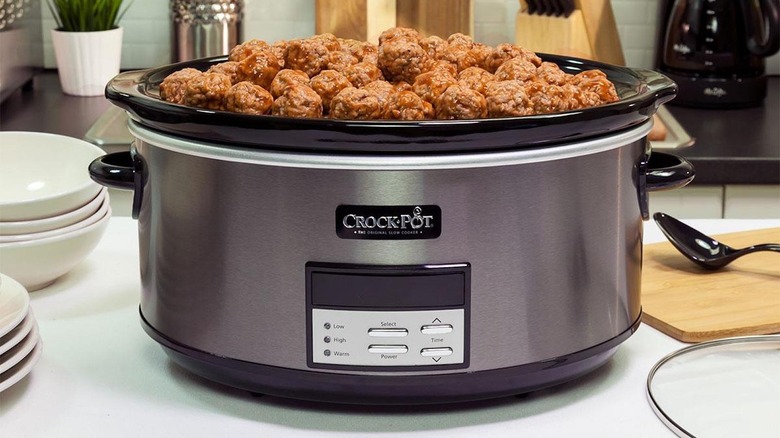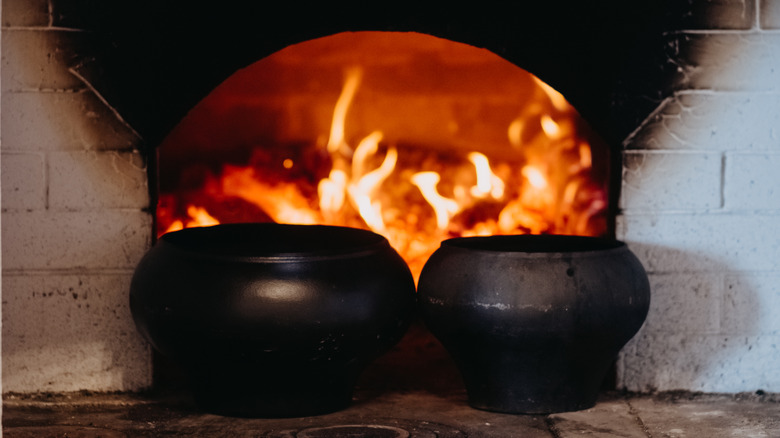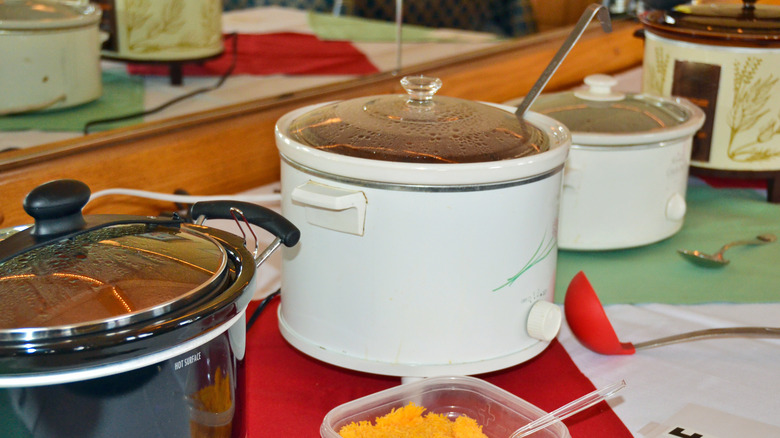How The Crockpot Nestled Its Way Into American Kitchens Everywhere
Just saying the name Crockpot conjures up comforting memories of bubbling stews or mulled apple cider for most Americans. The iconic ceramic slow cooker is still a fixture at holidays and potlucks and welcomes many of us home with a warm dinner. Other countertop appliances (looking at you, Instant Pot) may have more social media buzz, but the Crockpot has a place in our hearts as warm and reliable as the heating coils in its simple, recognizable unit.
Crockpot arrived in American kitchens in the 1950s as a moderately priced convenience appliance, and today nearly every small appliance maker has a version of the original slow cooker, including luxury versions priced over $250. The more complicated multi-cookers, in addition to pressure and rice cooking functions, also often have a slow cook setting, but because they have a metal rather than ceramic cook surface, aren't as suited to a single or multiple-day simmer. The fascinating story of this humble American kitchen helper has roots in a small village in Lithuania, from the mind of a prolific inventor.
The nostalgia that drove invention
Electrical engineer and inventor Irving Nachumsohn heard family stories about Sabbath food preparation in his ancestral village in Lithuania. The Jewish community used the remaining heat of the bread baker's oven on Friday to simmer covered dinner dishes containing beans and meat for Saturday's meal. Reflecting on the tradition, he set to work creating an electric appliance that could replicate that low, slow cooking, and in the late 1940s, the Naxon Beanery was born.
The original Naxon slow cooker was marketed to small food businesses such as diners and lunch counters, not homemakers. Nachumsohn himself was a practical problem solver, using his cooker as a way to keep the house cool when making summer dinners. But the bean cooking device did not make much of an impression on America until Nachumshon sold his electrical appliance business to Rival Manufacturing in 1970. Rival set a team of home economists to work creating recipes beyond the bean for the device and rebranded it as our now-familiar Crockpot. The timing was perfect — the oil crisis was causing energy prices to rise, and the Crockpot used far less electricity than the oven or stove. Rival provided time-saving recipes for busy households with two working parents, and sales sky(c)rocketed.
'Cooks all day while the cook's away'
The appeal of coming home to dinner ready to eat is timeless, and the Crockpot continues to help families get food on the table easily with less energy and fuss than stovetop cooking. While the original 1970s recipes typically included popular convenience food items like canned and powdered soup mixes, today's recipes span the globe and feature less processed food combinations. There are recipes for making homemade yogurt, breads, rice, and of course, hundreds of recipes for beans and meats that benefit from slow cooking.
The simple on-off, high-low settings of a Crockpot make it an approachable appliance for cooks of any ability level. Easy to use, easy to clean, and easy to bring right to the dinner table! No small wonder we all love our slow cookers. Irving Nachumsohn succeeded in building a way to cook his mother's nostalgic food memory, and in doing so, we all now share cozy memories of family meals. From your grandmother's chili to your mother's holiday meatballs to food writer Priya Krishna's Indian food recipes, there's a make-ahead dinner waiting to be the next generation of kitchen memories.


